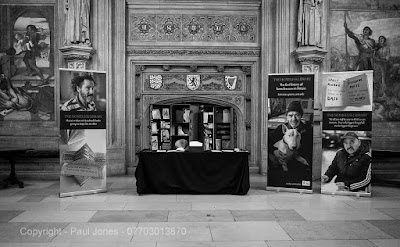It was an extraordinary experience for us to launch The Homeless Library at The Houses of Parliament yesterday - the first history of British homelessness. A powerful thing, to hear the voices of people who've experienced homelessness speaking in this place. It's been too long...
E's statement:
"I have been assaulted many times. A hundred times. One time I was in hospital afterwards, going under for an operation. The doctor asked me, 'What will you think about, when you're going under the anaesthetic?' I said, 'I'll think of gardening, and my nieces and nephew.'
"We all need good things in life, otherwise there's no point in living. This project is about making something good out of the bad stuff."
Jack Quashie's statement for THE HOMELESS LIBRARY launch:
"Homeless people all the time face abuse. How to stop this abuse? It's about respecting the homeless. If other people are educated: 'This is a homeless person. It is not their will to be homeless. It has happened for a reason.' Most homeless people have education, family, most are professionals. It can happen to anyone. Homelessness canot be stopped, but what can be stopped is the abuse."
Ann Coffey MP:
"This is not only a history of facts, the very material of each of these handmade books in The Homeless Library tells its own story. It is full of emotion. I feel I can reach out and touch it."
Sara Hilton, Head of Heritage Lottery Fund North West:
“I was honoured to be in parliament yesterday to see first-hand the amazing artwork that has been produced for the homeless library. This feels like a really important moment - giving voice to a marginalised group and telling their hidden history in the heart of Westminster. We are proud to have supported it with National Lottery players’ money and I’d urge everyone to make time to go and see it when it goes to the South Bank, and then tours the North West later this year.”
Jonathan Billings, Manager of The Wellspring homeless resource centre:
"Service users and staff have taken part in The Homeless Library, this has been an empowering experience for all involved and one that will live long in the memory. Providing homeless and disadvantaged people opportunities to get involved in creative experiences is very meaningful, it helps people raise their confidence and their ability to work positively around areas of their lives that present problems and barriers. The Wellspring has been delighted to have worked with arthur+martha on this project."
Marcus Jones, Under Secretary of State for Communities and Local Government:
"The Houses of Parliament is a place that is full of history. By bringing your Homeless Library here, and speaking here you, are connected to all of our history. It will be heard."
Photography by Paul Jones. Photographs at Upper Waiting Hall, The Houses of Parliament, 24 May 2016. Many thanks to Paul for kindly donating his time and skill to this project.
The Homeless Library project is supported by the Heritage Lottery Fund.
The Homeless Library project is supported by the Heritage Lottery Fund.








